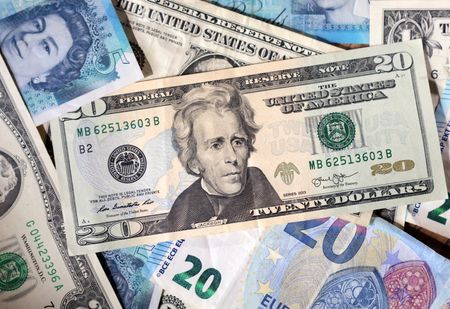By Kevin Buckland and Lucy Raitano
TOKYO/LONDON (Reuters) -The U.S. dollar rose slightly against other major currencies on Thursday, but stayed close to multi-week lows as bets that the Federal Reserve will resume cutting interest rates next month ticked higher.
Bucking the trend was the yen, with the dollar hitting a three-week low against the Japanese currency after U.S. Treasury Secretary Scott Bessent suggested the Bank of Japan needs to raise rates again soon, while the Fed cuts aggressively.
Rising expectations for monetary easing combined with increasing institutional cryptocurrency investment powered bitcoin to a new record peak earlier in the session.
Fed rhetoric has turned broadly more dovish on signs of a cooling U.S. labour market, while President Donald Trump’s tariffs are yet to add significantly to price pressures.
Traders see a Fed rate cut on September 17 as a near certainty, according to LSEG data, and even lay around 7% odds on a super-sized half-point reduction.
“For the markets, it’s not even a matter of if the Fed cuts interest rates in September, it’s a question of how much,” said Kyle Rodda, an analyst at Capital.com.
“Signs of a downturn in the labour market have pushed futures to bake in a series of rate cuts before the end of the year.”
The Fed also continues to be under intense political pressure to ease.
Trump has repeatedly criticised Fed Chair Jerome Powell for not cutting rates sooner, even threatening to oust him before Powell’s term expires in May.
Treasury Secretary Scott Bessent on Wednesday called for a “series of rate cuts,” and said the Fed could kick off the policy easing with a half-point cut.
Francesco Pesole, FX strategist at ING, said a 50 bps rate cut is not very realistic right now.
“In order for the market to price 50 basis points in, we would probably need some indication from other Fed members that they are somewhat open to the idea,” he said.
Traders are now looking ahead to U.S. PPI figures for July due later in the session.
“If that comes in soft or below expectations that can add a little bit of easing,” said ING’s Pesole.
Bessent said the BOJ had gotten “behind the curve” by delaying rate hikes.
“Bessent’s comments are having a strong impact on USDJPY,” said Norihiro Yamaguchi, an economist at Oxford Economics.
At the same time, “gains in the yen are being accelerated by low liquidity in the market as fewer market participants are around this week” due to the Obon holiday, he said.
The U.S. dollar dropped as much as 0.8% to 146.22 yen on Thursday, its weakest since July 24, and was last down 0.5%.
The euro was down 0.24% at $1.1677, coming off Wednesday’s peak of $1.1730, a level last seen on July 28.
The pound barely reacted to UK GDP data that showed the economy slowed less than expected in second quarter. Sterling was last down 0.1% at $1.35645.
Meanwhile, bitcoin earlier hit its first record peak since July 14, pushing as high as $124,480.82 before trimming gains and was last down 1% at around $121,685.
Bitcoin was already underpinned by increased institutional money flows this year in the wake of a spate of regulatory changes spearheaded by Trump, who has billed himself the “cryptocurrency president.”
In the latest move, an executive order last week paved the way to allow crypto assets in 401(k) retirement accounts.
“Corporate treasuries like MicroStrategy and Block Inc. continue to buy bitcoin,” said IG analyst Tony Sycamore.
“Technically, a sustained break above $125,000 could propel bitcoin to $150,000.”
The Australian dollar had earlier advanced as much as 0.4% to the highest since July 28 at $0.65685, but was last down 0.16%.
(Reporting by Kevin Buckland in Tokyo and Lucy Raitano in London; Editing by Shri Navaratnam; Editing by Sam Holmes and Jane Merriman)











